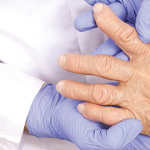
Constantin Stanciu / shutterstock.com
AMSTERDAM—Early identification and treatment of rheumatoid arthritis (RA) are two of the most pressing concerns in the field, an expert said at EULAR: the Annual European Congress of Rheumatology. He described the latest efforts to identify patients at risk of RA development and insights on quick referral to rheumatologists.
Karim Raza, BM, BCh, PhD, Arthritis Research UK professor of rheumatology at the University of Birmingham in the United Kingdom, said a major challenge is discerning which patients with early, undifferentiated RA or clinically suspect arthralgia will go on to develop RA.
Total IgG Glycosylation
In an analysis of data from the Leiden Early Arthritis Cohort, researchers looked at those who were classified as having undifferentiated RA under the 1987 criteria and then developed RA within one year under those criteria.1 They asked: Would the 2010 criteria perform better, capturing at baseline those who would have progressed to RA? They found the 2010 criteria tended to capture those who were positive for anti-citrullinated protein antibody (ACPA), rheumatoid factor or both. But it did not tend to capture those patients who were negative for both.
“The issue relates to the seronegative group,” Dr. Raza said. “This is really where the biggest problem arises—for seronegative early undifferentiated arthritis. … This is a group for which there is a need for a better understanding for how to predict who will go on to develop a persistent disease, such as RA.”
Research has found that other RA-associated antibody classes measured at baseline, for example anti-carbamylated protein antibody, do not tend to do well in predicting RA progression for patients who are seronegative for ACPA and RF, he said.2
A hopeful note may be found in the study of sugar residues that coat autoantibodies and antibodies in general. Researchers in China have developed an assay that can detect very low levels of N-glycans on total immunoglobulin. They found that total IgG glycosylation with these glycans is different from RA patients than controls, even among those who are ACPA- and RF-negative.3 This test performs well, with a high predictive value for RA, they said.

Dr. Raza
“This gives us an antibody-based biomarker that’s not dependent upon the traditional RA-associated antibodies,” Dr. Raza said. “I think this is likely to be a space that we need to watch over the next few years.”
Tenosynovitis
In other research, investigators looked systematically to see whether identifying tenosynovitis gave added value over synovitis for the prediction of RA development in patients with very early arthritis. And they found that it does.4 Clinicians also struggle with how to proceed with patients who have “clinically suspect arthralgia”—those who don’t have swollen joints, but who have “inflammatory-sounding” joint symptoms that prompt concern about potential RA development.
One tool developed for this group is EULAR’s Symptoms in Persons at Risk of Rheumatoid Arthritis questionnaire, which attempts to systematically paint a picture of a patient’s total symptom experience with arthralgia.5
“I suspect it will be an important tool for us to try and understand whether there are symptoms that you can perhaps get GPs to start pinpointing, so they know who to refer to us,” Dr. Raza said.
‘If you tell people that they’re at increased risk & why they’re at increased risk, then they’re encouraged to change their behavior to reduce their risk,’ Dr. Raza said.
Environmental & Lifestyle Factors
A study on the ability of autoantibody tests to ascertain risk in those with clinically suspect arthralgia found that such tests do not make a definitive prediction. Researchers said the “presence of ACPA and RF is insufficient for accurately identifying imminent ACPA-positive RA. They found a third of patients with clinically suspect arthralgia and who are ACPA and RF positive still won’t progress to RA.6
An expanding area of literature, Dr. Raza said, has been exploration of environmental factors that could be modulating the immune system and affecting whether patients do or do not progress from one risk phase to the next.
In one study, patients who were ACPA positive but without RA at baseline, but later developed RA, were found to have lower levels of the omega-3 fatty acid, docosapentaenoic acid (DCPA).7
“I think this is an example of a paper [that] will show the measurement of environmental factors like this will help us predict RA progression over time,” he said.
Anti-CCP antibodies in the sputum also might offer a clue to the chances of RA progression. A study earlier this year found that levels of the autoantibodies were higher among those at a high risk of RA.
Importantly, this sometimes matched with the equivalent antibody in the blood, but sometimes it didn’t.8
“As we getting earlier and earlier toward when immune tolerance is broken and when disease begins from an immunological perspective, we need to think about looking at autoantibodies in other places besides the blood,” Dr. Raza said.
Still more research has found that lifestyle changes appear to be more likely if the risk is presented to patients in a certain way. A study of those with first-degree relatives with RA were told what their lowest possible risk was, based on unmodifiable factors, such as age and their close relationship with an RA patient. And they were told what their modifiable risk, based on such factors as diet and smoking, was. These patients were more likely to want to make lifestyle changes.9
“If you tell people they’re at increased risk and why they’re at increased risk, then they’re encouraged to change their behavior to reduce their risk,” Dr. Raza said.
Early Treatment
Even with advances in identifying those at increased risk of moving from an early phase to full-blown RA, these advances can’t be put to use if patients aren’t seen. But the problem of general practitioner referral is a massive one, because so many patients making a visit to a GP report issues with joints. Half of them, for example, report joint stiffness.
National surveys in the United Kingdom have found that only a fraction of GPs will refer a patient to a rheumatologist immediately even if they suspect RA—with many performing initial tests to inform their referral decision, Dr. Raza said.
Online tools meant to sharpen the ability of GPs to more accurately assess the RA risk are being developed, but Dr. Raza cautioned that they are only as good as the algorithms that underlie them. He said he is encouraged by the amount of work being done in this area.
“If you want to diagnose RA early, you have to see patients with RA early. And there are actually quite a lot of initiatives going on.”
Thomas R. Collins is a freelance writer living in South Florida.
References
- Boeters DM, Gaujoux-Viala C, Constantin A, et al. The 2010 ACR/EULAR criteria are not sufficiently accurate in the early identification of autoantibody-negative rheumatoid arthritis: Results from the Leiden-EAC and ESPOIR cohorts. Semin Arthritis Rheum. 2017 Oct;47(2):170–174.
- Boeters DM, Trouw LA, van der Helm-van Mil AHM, et al. Does information on novel identified autoantibodies contribute to predicting the progression from undifferentiated arthritis to rheumatoid arthritis: A study on anti-CarP antibodies as an example. Arthritis Res Ther. 2018 May 3;20(1):94.
- Wang J-R, Gao W-N, Grimm R, et al. A method to identify trace sulfated IgG N-glycans as biomarkers for rheumatoid arthritis. Nature Commun. 2017 Sep 20;8(1):631.
- Sahbudin I, Pickup L, Nightingale P, et al. The role of ultrasound-defined tenosynovitis and synovitis in the prediction of rheumatoid arthritis development. Rheumatology (Oxford). 2018 Apr 3; [Epub ahead of print]
- van Beers-Tas MH, Ter Wee MM, van Tuyl LH, et al. Initial validation and results of the Symptoms in Persons at Risk of Rheumatoid Arthritis (SPARRA) questionnaire: A EULAR project. RMD Open. 2018 May 21;4(1):e000641.
- Ten Brinck RM, van Steenbergen HW, van Delft MAM, et al. The risk of individual autoantibodies, autoantibody combinations and levels for arthritis development in clinically suspect arthralgia. Rheumatology (Oxford). 2017 Dec 1;56(12):2145–2153.
- Gan RW, Bemis EA, Demoruelle MK, et al. The association between omega-3 fatty acid biomarkers and inflammatory arthritis in an anti-citrullinated protein antibody positive population. Rheumatology (Oxford). 2017 Dec 1;56(12):2229–2236.
- Demoruelle MK, Bowers E, Lahey LJ, et al. Antibody responses to citrullinated and noncitrullinated antigens in the sputum of subjects with rheumatoid arthritis and subjects at risk for development of rheumatoid arthritis. Arthritis Rheumatol. 2018 Apr;70(4):516–527.
- Sparks JA, Iversen MD, Yu Z, Triedman NA, et al. Disclosure of personalized rheumatoid arthritis risk using genetics, biomarkers, and lifestyle factors to motivate health behavior improvements: A randomized controlled trial. Arthritis Care Res (Hoboken). 2018 Jun;70(6):823–833.


